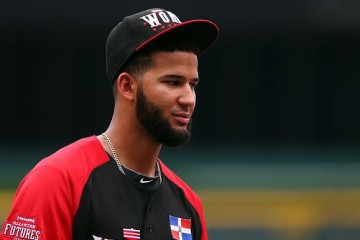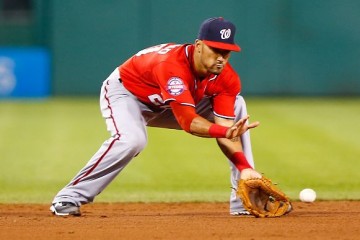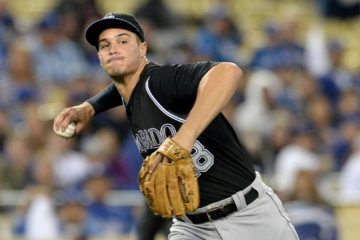2014 Fantasy Baseball: Is Ian Desmond an Elite Shortstop?
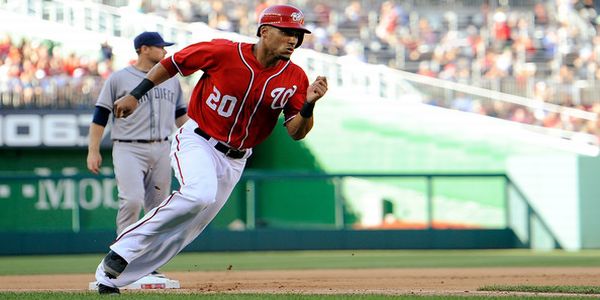

Projections for the 2014 season are out from steamerprojections.com. After the 2012 season, Razzball did a study on the most accurate projection systems, and Steamer seemed to be one of the better systems at projecting both hitting and pitching. So I wanted to find a way to turn the Steamer projections into one fantasy value number, something similar to ESPN’s player rater. Thankfully, Zach Sanders came up with a system back in 2011 to do exactly that. If you’d like to read about the methodology, you can do so here, here, here and here. And if you’d like to see how Steamer projects hitters and starters to finish the year in terms of fantasy production, check out this Google Doc.
I’m in the process of going position-by-position and comparing the Steamer fantasy values to NFBC ADP. I previously looked at catchers, first basemen, second basemen, third basemen and underdrafted shortstops. Today I’ll look at shortstops that Steamer thinks are overdrafted. Well, actually, I’ll just be looking at one.
PREPARE FOR YOUR UPCOMING DRAFTS BY PURCHASING OUR 2014 FANTASY BASEBALL DRAFT GUIDE
Ian Desmond / Steamer Projection: #11 SS / ADP: #5 SS
To have Desmond outside the top ten at shortstop seems insane at first glance. He was second among shortstops and the 55th most valuable player overall according to Zach Sanders’ end-of-season valuations, and he was third at his position and 44th most valuable overall according to ESPN’s player rater. So why in the world would anyone have him ranked outside the top ten shortstops?
To be fair to Steamer, these aren’t rankings they’ve produced. I’ve taken their projections and run them through a model to give me some rankings to work with. But it’s obvious that the model expects Desmond to regress quite a bit.
As it turns out, the biggest reason for the projected regression is a projection of almost 100 fewer plate appearances than he had last year (655 to 556). In 2010 and 2012 Desmond failed to reach 600 PA. An oblique injury cost him about a month in 2012, and hitting at the bottom of the lineup until August in his first year as a regular in 2010 kept him under 600 PA. I see no reason why one month-long DL stint in 2012 should be reason to project 100 fewer PA.
The Fangraphs fan projection of 643 PA seems more like it. So what would the Steamer projection look like if you extrapolated his roto projections out to that number of PA?
This is where it becomes clear that Steamer isn’t just down on Desmond because it expects him to get to the plate less. This projection has him at one homer fewer than last year, four fewer steals, and a R+RBI total that is 14 fewer than last year. The homer is obviously negligible. But the steals, runs and RBI dropping all add up, and they seem to be a result of the projected drop in batting average. Fewer hits means fewer runs and RBI and fewer opportunities on base to steal a bag. The big question is whether the average will really drop.
Over the last two years, Desmond hit .286 with the help of a .335 BABIP. His xBABIP over that time frame is .328, so there’s no reason to project a batting average drop on the “lucky BABIP” argument. But you could argue that it might drop because of a concerning trend in his contact skills. His contact rate has dropped and his swinging strike rate has risen in each of the last two seasons, and it’s dropping because he’s making quite a bit less contact on pitches in the zone. His contact rate was all the way down to 75.3% last year resulting in a career high 22.1% strikeout rate.
If you’re not aware, 75.3% is a horrible contact rate. To put it in perspective, only 183 of 1,509 qualified hitters in the last decade had a contact rate of 75% or lower. In other words, guys who make that level of contact don’t often get a lot of work. Of those 183 hitters, their combined batting average was .262. When you just consider the guys in that sample who had a contact rate between 75.3% and 74.3%, their combined batting average was .272. If Desmond’s contact skills continue down that path, it’s going to be very tough for him to maintain an above average BABIP and a batting average above .275.
That’s especially true if Steamer’s projected loss in speed actually happens. And there is good reason to think it might. In the graph below (taken from Fangraphs), you can see the aging curve for speed over the last decade. The red line is the one that applies to Desmond as he has reached 20 steals in a single season. As you can see, the curve shows an average drop of about three steals at Desmond’s age, 28. Our adjusted projection with the increased playing time has Desmond stealing exactly three fewer bases than last year. This doesn’t mean that his average is going to fall off the map. It just means that if his contact problems get worse, he’s probably not going to be able to compensate for that with the same level of speed he has had in the past.
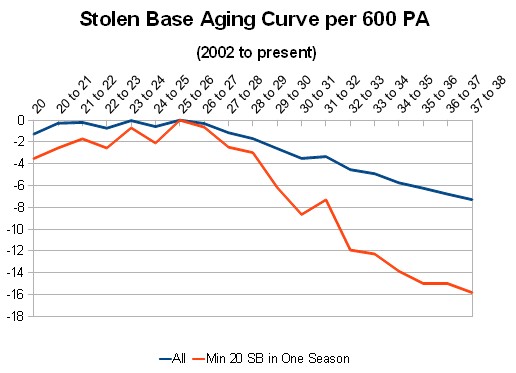
After all that, I’d say that I agree with the extrapolated Steamer projection. The .266 projected average is right in that .262-.272 range I discussed, and, as a result, the moderate drop in runs and RBI seems about right. And of course I agree with the three fewer steals given what we know about the speed aging curve. If that’s the right projection, and not the one based on 556 PA, where would that place Desmond among shortstops?
When I re-run Sanders’ method with the extrapolated projection, Desmond ranks as the fourth most valuable shortstop behind only Tulo, Reyes and Hanley. His projected value works out to be quite a bit less than those guys, but it makes a lot more sense for a power/speed option at shortstop to rank in the top five rather than outside the top ten. With that extrapolated projection, Desmond is projected to have the fourth most valuable home run total at the position, ninth most valuable run total, fourth most valuable RBI total, and ninth most valuable steal total. Even his batting average is projected to be an above average contribution, even if just barely.
Combined, that four category production makes for a solid, if not quite elite, option. And that “not elite” distinction is important because Desmond is projected to be the 63rd most valuable player in the Sanders system yet his current NFBC ADP is 35th overall, one spot behind Reyes. ESPN has him ranked 24th overall. He’s not nearly as bad as the Steamer projection would lead you to believe, but he’s also not as good as his ADP indicates people think he is. Avoid him that early, but feel free to snatch him up is he falls outside the top 50, which is admittedly unlikely. Here are a couple of other articles of mine suggesting that Alexei Ramirez and Everth Cabrera might be better SS options a little later in your draft.



